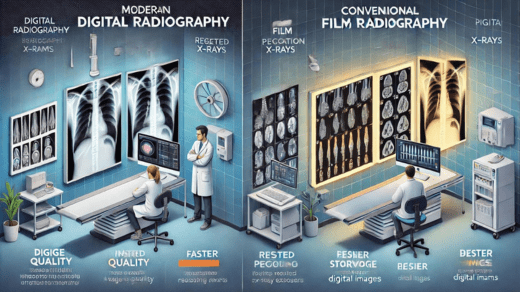Film-based X-rays were the standard option in medical imaging back then. With technological developments, digital X-rays have altered the medical world. If you wish to understand their benefits over film X-rays, welcome to this post. Let’s learn about the three advantages of digital X-rays over the traditional process.
An Overview of Digital vs Film X-Rays
The medical world has undergone many changes. The transition from conventional film to digital X-rays has offered various benefits to the healthcare system. Digital X-rays require less radiation exposure than the traditional method, so they’re a safer option for patients.
Plus, it removes the need for storing X-rays physically as these images can be stored on devices. The reason why it is better than traditional film X-rays is because it ensures improved patient care. Let’s find out the top benefits from the following points:
Improved Image Quality
One of the most noticeable benefits of digital X-rays is the better image quality they offer. Thus, they capture pictures with more resolution and clarity than film-based ones. Accurate and improved image quality make digital X-rays a better choice.
With detailed visuals, radiologists view the results in areas that may seem too bright or dark on film X-rays. Also, digital X-rays have better image processing. These images are altered by adjusting the contrast and brightness, making diagnosis more effective and easy.
Faster Results and Convenience in Sharing Files
Unlike film X-rays, which require time-consuming processing, digital images are ready for viewing almost instantly. Since the images are instantly available, it reduces the waiting time and lets doctors make decisions about patient care more speedily. The swift process of examining and capturing images helps simplify the work for healthcare professionals.
Developing the film and transporting it physically to the radiologist would take a lot of time, considering the traditional film-based technique. Digital X-rays eliminate this process and are easily shared across various systems. Sharing X-ray files from one device to the other helps healthcare experts improve patient treatment plans.
Sustainable Impacts with Lower Radiation Exposure
The next environmental advantage of X-rays is that they do not use chemicals, unlike film X-rays. Chemicals used in conventional X-rays are toxic and must be disposed of properly. Digital X-rays, on the other hand, reduce waste production. So, patients and doctors, especially those who are exposed to X-rays on a daily basis, can benefit.
This type of X-ray can easily retake or adjust digital images without additional radiation exposure. Suppose the image is not optimal. In such cases, it gets immediately reviewed and retaken if required without the need for a new exposure.
Technological progress may bring more advancements to digital X-rays. Constant development and innovations in AI and ML are set to offer new opportunities for image analysis and diagnosis procedures.
This digital revolution not only replaces film X-rays but also ensures patients get better care from healthcare experts. With newer technological revolutions, patients can get accurate diagnoses, speedier treatment decisions, and an improved healthcare experience.

